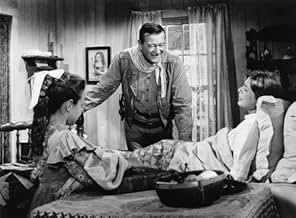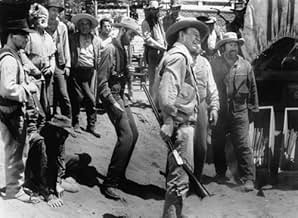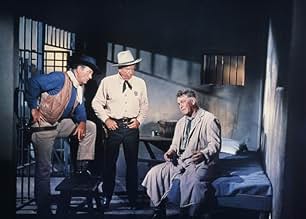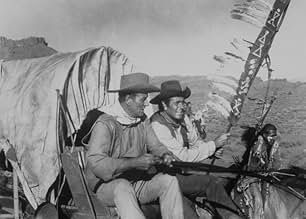En 1843, Paul tue un rival en duel et s'enfuit. Il est pourchassé et arrêté par Jake, capitaine des Rangers. Les deux hommes ainsi que les Rangers affronteront les Comancheros, brigands blan... Tout lireEn 1843, Paul tue un rival en duel et s'enfuit. Il est pourchassé et arrêté par Jake, capitaine des Rangers. Les deux hommes ainsi que les Rangers affronteront les Comancheros, brigands blancs qui s'allient aux Indiens.En 1843, Paul tue un rival en duel et s'enfuit. Il est pourchassé et arrêté par Jake, capitaine des Rangers. Les deux hommes ainsi que les Rangers affronteront les Comancheros, brigands blancs qui s'allient aux Indiens.
- Réalisation
- Scénario
- Casting principal
- Récompenses
- 2 victoires et 3 nominations au total
- Tobe
- (as Pat Wayne)
- Nervous Drunk
- (non crédité)
- Martha Schofield
- (non crédité)
- Comanchero
- (non crédité)
- Barfly
- (non crédité)
- Card Dealer
- (non crédité)
Avis à la une
I was pleasantly surprised. This movie is a lot of fun, as long as you do not try to make sense of it, and do not take it seriously.
Beautiful landscapes, a great score by Elmer Bernstein, a terrific, performance by Wayne (who looks like he's having the time of his life surrounded by his real-life children on the set) and a show stealing role by Lee Marvin, who looks as though he has a bunch of "Silly Putty" sitting on top of his head (not the best make-up job, guys).
I'm so glad I invested the time to watch this. You will be too.
In a way the movie is three movies, consisting of three separate but connected story arcs, any or each of which could have been beefed up and expanded into movies unto themselves. The story is thusly layered with complexity, which keeps it all interestingly moving along apace, never bogging down. It is also however the source of the movie's only real flaw. And that flaw is, as other reviewers have noted, the movie's presentation of a dubious and flawed historical chronology. And it isn't just little anachronisms like repeating rifles out of time. There is a complete confusion of historical eras and historical settings. Even though the story is set in 1843, its time seems to vacillate throughout, in one arc staying true to the story it is or purports to be, a story set in the antebellum south, but then jumping in another arc to a story appearing to be more similar to the further-western and decades later Indian wars, circa the 1870s. It seems as if there was lot of trouble deciding which of those two kinds of stories the movie was telling, a story about events in the antebellum south or a shoot-em-up story of the western Indian wars. It is likely a problem of scriptwriting, having had numerous "treatments" or rewrites by more than one writer, and those seams show. My guess is ultimately director Michael Curtiz and producer George Sherman must have decided that the typical ticket-buyers for this movie would be fans of John Wayne westerns, and that target audience would not be comprised of history majors or even history buffs, or be ones to get hung up on historical details, so they just let the historical flaws slip through.
There is one unintentionally funny moment in the movie. About mid-way through, watch for the blood-curdling scream by the bed-ridden lady (Joan O'Brien?) at the outpost when she looks out the window and sees the supposed Indian raiders crossing the river. It is truly a classic and world-class movie scream. I wonder how many takes that took.
One of the movie's three story arcs features Lee Marvin. This is a pre-Cat Ballou, pre-Dirty Dozen Lee Marvin who at this point in his career wasn't really yet a bigtime Hollywood household name, at least not like he would later become. Marvin turns in a marvelous over-the-top performance as a gun-dealing rapscallion, in my opinion flat-out stealing every scene he's in. That's no small feat, considering in all of his scenes he was playing directly off against John Wayne, who almost fades into the woodwork in the comparison. Actually Wayne sublimates himself quite well. He knew how to be a team player, and the chemisrty between Wayne and Marvin is good. Unfortunately this story arc is really nothing much more than a side-story than anything else, so Marvin's role is quite limited. Too bad. I would've liked to have seen a lot more of Marvin in this film. It would have been a better movie for it.
Lee Marvin, John Wayne and Marvin appeared together again two years later in John Ford's Donovan's Reef, with Marvin again playing a lesser role.
This movie pops up regularly on the Encore Westerns channel. I've seen it there about 5 times over the last 6 months. Watch for it.
Coming right in between the farcical NORTH TO THE ALASKA (1960) and the elegiac THE MAN WHO SHOT LIBERTY VALANCE (1962), it’s neither as comic as the former nor as grim as the latter, but manages to strike a good balance between the two. The film has an interesting episodic structure: Texas Ranger Wayne chasing gambler Stuart Whitman (accused of murder), Whitman meeting mystery woman Ina Balin on a boat (having slipped from Wayne’s fingers), Wayne crossing paths with psychotic arms dealer Lee Marvin (with a prominent scalp), Wayne and Whitman eventually team up to rout the Comancheros – a renegade band with their own strict code of ethics who’s in league with the Indians (they’re led by Nehemiah Persoff, incidentally Balin’s father).
Wayne and Whitman work well together: the latter eventually co-starred in a similar Fox Western, RIO CONCHOS [1964], which is yet to be released on DVD – but, as it happens, has just been shown on Italian TV and I taped it for an instant reappraisal; Marvin has a brief but showy role, Persoff makes a fine villain, and Balin’s strong character is unusual for a Western (though she eventually reforms for the sake of Whitman!). There’s also a good supporting role for Wayne’s son, Patrick; and, while I don’t know how much say Curtiz had in casting the film, it was great to see two alumni of his in nice bits – Henry Daniell (from THE SEA HAWK [1940]) and Guinn “Big Boy” Williams (from DODGE CITY [1939]).
As can be expected, THE COMANCHEROS features plenty of well-staged action sequences (including a climactic bout in which all the various parties involved clash) – all set to a rousing Elmer Bernstein score, fresh from THE MAGNIFICENT SEVEN (1960). Watching the film got me thinking about another good Wayne Western from this later period which I haven’t watched in over 20 years – THE WAR WAGON (1967; incidentally, the last of 3 collaborations with Kirk Douglas) – which is actually upcoming on R1 DVD as part of a Universal “John Wayne Screen Legends” set...
One of those rare movies that you hate to see end...
I rate it a 9.9 out of 10.
Cecil B. DeMille was of the opinion that motion pictures have to move. He wouldn't have anything to complain about The Comancheros on that score. There's not a dull moment in the film. This was the last directorial effort of Michael Curtiz and he kept the action flowing.
Three things stand out in The Comancheros. First Elmer Bernstein's music keeps the action going. You will be humming that theme days after viewing this film. Secondly the Cinemascope photography is breathtaking even viewing a formatted VHS copy. I remember seeing The Comancheros in the Sheepshead Bay Movie Theatre in Brooklyn as a lad and a theater is where this film should really be viewed.
But mostly since the two of them are on the screen together for about half the film, the chemistry with John Wayne as Texas Ranger Jake Cutter and Stuart Whitman as fugitive Paul Regret is what sets the whole tone of the film. Wayne and Whitman only worked one other time together and that was in The Longest Day. They were such a perfect fit it's a pity they didn't do more together.
This was also the first time the Duke worked with Lee Marvin. Marvin's character is only on screen for about 10 minutes, but you remember him throughout. This is also the final screen appearance of Guinn "Big Boy" Williams who must have done at least fifteen films with Michael Curtiz back in the heyday of Warner Brothers.
The Comancheros deserves an honored place in the performances of John Wayne and can't be beat for entertainment. A MUST for Duke fans.
Le saviez-vous
- AnecdotesGeorge Sherman produced this film, and Michael Curtiz directed it. During much of the shooting, Curtiz was seriously ill: he died of cancer shortly after the film's release. On the days when Curtiz was too ill to work, John Wayne took over direction. When the film was completed, he told the studio that he did not want credit as co-director and insisted that Curtiz's name alone appear as director. Wayne performed the same function in 1971 on "Big Jake (1971)," which was directed by Sherman, who took ill during production. Wayne directed the film on the days when Sherman couldn't and again insisted that he not receive co-director credit.
- GaffesThe guns used in the movie are Colt Single Action model 1873 revolvers, look-alike Henry lever-action model 1860 rifles, and Winchester model 1892 lever-action rifles. The only correct period guns are the single-shot percussion-cap dueling pistols used in the opening scene.
- Citations
[while Regret and Cutter are tied up as prisoners]
Paul Regret: I wonder if they know how much trouble they're in.
- Versions alternativesWhen originally released theatrically in the UK, the BBFC made cuts to secure an 'A' rating. When released on home video in 1988, the BBFC made cuts of 11 seconds to remove shots of horse-falls to secure a 'PG' rating. For the DVD release, the BBFC made cuts of 8 seconds in 2003 to remove similar shots of horse-falls resulting in a 'PG' rating. To date (December 2014), the film has not been released fully uncut on UK media.
- ConnexionsFeatured in Hollywood Remembers Lee Marvin (2000)
- Bandes originalesThe Comancheros
Music & Lyrics by Tillman B. Franks (as Tillman Franks)
Meilleurs choix
Détails
Box-office
- Budget
- 4 260 000 $US (estimé)
- Durée1 heure 47 minutes
- Couleur
- Rapport de forme
- 2.35 : 1
Contribuer à cette page




































